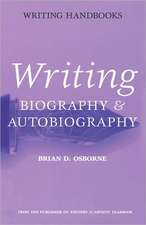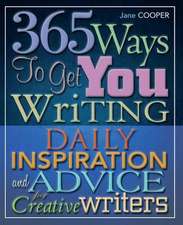Environmental and Nature Writing: A Writer's Guide and Anthology: Bloomsbury Writer's Guides and Anthologies
Autor Dr Sean Prentiss, Dr Joe Wilkinsen Limba Engleză Paperback – 16 noi 2016
| Toate formatele și edițiile | Preț | Express |
|---|---|---|
| Paperback (1) | 164.43 lei 3-5 săpt. | +56.58 lei 4-10 zile |
| Bloomsbury Publishing – 16 noi 2016 | 164.43 lei 3-5 săpt. | +56.58 lei 4-10 zile |
| Hardback (1) | 602.27 lei 3-5 săpt. | |
| Bloomsbury Publishing – 16 noi 2016 | 602.27 lei 3-5 săpt. |
Preț: 164.43 lei
Preț vechi: 198.32 lei
-17% Nou
Puncte Express: 247
Preț estimativ în valută:
31.46€ • 32.85$ • 25.98£
31.46€ • 32.85$ • 25.98£
Carte disponibilă
Livrare economică 25 martie-08 aprilie
Livrare express 08-14 martie pentru 66.57 lei
Preluare comenzi: 021 569.72.76
Specificații
ISBN-13: 9781472592538
ISBN-10: 1472592530
Pagini: 400
Ilustrații: 1 b/w illustration
Dimensiuni: 156 x 234 x 23 mm
Greutate: 0.59 kg
Editura: Bloomsbury Publishing
Colecția Bloomsbury Academic
Seria Bloomsbury Writer's Guides and Anthologies
Locul publicării:London, United Kingdom
ISBN-10: 1472592530
Pagini: 400
Ilustrații: 1 b/w illustration
Dimensiuni: 156 x 234 x 23 mm
Greutate: 0.59 kg
Editura: Bloomsbury Publishing
Colecția Bloomsbury Academic
Seria Bloomsbury Writer's Guides and Anthologies
Locul publicării:London, United Kingdom
Caracteristici
An up-to-date practical introduction to writing about the environment in a wide range of genres, with writing prompts and discussion questions throughout
Notă biografică
Sean Prentiss is Associate Professor of English at Norwich University, USA. He is author of Finding Abbey: The Search for Edward Abbey and His Hidden Desert Grave (2015), which won the National Outdoor Book Award for Biography/History. He is also co-editor of The Far Edges of the Fourth Genre (2014). Joe Wilkins is Associate Professor of English at Linfield College, USA. His memoir, The Mountain and the Fathers: Growing Up on the Big Dry (2013) won the GLCA New Writers Award for non-fiction and his work has appeared in Georgia Review, Harvard Review and Slate among many other periodicals.
Cuprins
Section 1: An Introduction to Nature and Environmental WritingChapter 1: The TrailheadChapter 2: A Short History of Nature and Environmental Writing Section 2: The Craft of Nature and Environmental WritingChapter 3: Seeing the World, Believing the WorldChapter 4: Living MapsChapter 5: The Writer in PlaceChapter 6: People and PlaceChapter 7: The River Above, the River BelowChapter 8: The Art of ActivismChapter 9: A World Larger than OurselvesChapter 10: The Nature and Environmental Essay, Story, and PoemChapter 11: One More Time to the River: Writing is RewritingChapter 12: A Trail Guide Section 3: Nature and Environmental Writing AnthologyCreative Nonfiction Geologies: An InvestigationChelsea Biondolillo Pack RatJohn Daniel Tales From a Black Girl on Fire, or Why I Hate to Walk Outside and See Things BurningCamille T. Dungy Nature Writing by NumbersDavid Gessner Exposed: The Mammogram Myth and the Pinkwashing of AmericaJennifer Lunden Burning the ShelterLouis Owens Spring Ends in Bangor, PASean Prentiss Hell Yeah We Want Windmills Erik Reece The Other Side of FireLeslie Ryan Trapline: An Ojibwe Man's Search for Identity on the Canadian TaigaDavid Treuer Fiction Family ReunionBonnie Jo Campbell BorderAlyson Hagy CartographyBonnie Nadzam Mule KillersLydia Peelle The Caves of OregonBenjamin Percy Like Bread the LightJoe Wilkins Poetry Creation MythElizabeth Bradfield I Was Popular in Certain Circles Gabrielle Calvocoressi What My Neighbor Tells Me Isn't Global WarmingTodd Davis Weekly Apocalyptic, or Poem Written on the Wall in an Ascending Space CapsuleChris Dombrowski Resurrection of the Errand Girl Nikky Finney Water Water Water Wind Water Juan Felipe Herrera MigrationMajor Jackson Remembering MinidokaW. Todd Kaneko River KeeperLaurie Kutchins Emerging View Anne Haven McDonnell Coos BayMichael McGriff Explaining Seafood to My Future Grandkids after the ExtinctionJuan Morales Lewis and Clark DisagreeAimee Nezhukumatathil The Natural World G.E. Patterson StrippingSean Prentiss As a Species Flies from Extinction, Consider the RiverDerek Sheffield Migration of Balling TwineJulia Shipley The FeedM.L. Smoker Theories of Time and SpaceNatasha Trethewey Seven DevilsJoe Wilkins Tire Hut: Seaview, WashingtonMaya Jewell Zeller
Recenzii
This book presents an introductory history of nature writing-covering subcategories ranging from pastoral and adventure writing to postcolonial and climate change narratives-and serves as a comprehensive guide to the elements of its craft in essays, stories, and poems. Both veterans and newcomers to environmental and nature writing will find inspiration in the exercises and anthology sections, which include work by Camille T. Dungy, Juan Felipe Herrera, Benjamin Percy, and many others.
The planet is in a real crisis - and one good effect is that it seems to be producing ever more wonderful writers about nature and the environment, almost as a human produces antibodies to ward off disease. Here you will find introductions to many of them--and an invitation to join their ranks.
Sean Prentiss and Joe Wilkins' new craft text and anthology, Nature and Environmental Writing, is a writing manual full of provocative prompts and a respectful and informative literary history of the genre we have previously kept in a small box marked "nature writing." It also includes a discerning multi-genre reader. The book challenges writers to factor into their writing the imprint of place and landscape on the human story. Whether writers adopt this textbook for a classroom setting or embark upon its lessons and inspirations in a self-study, they will surely come away with new and wild ideas about the subtle influences that science, the natural world, and the environmental imagination exert on all of our experiences, memories, and stories.
This is lucid, interesting and highly readable.
The sense of historical development coupled with the sensitivity to the changing social and cultural landscapes makes this book useful to a number of audiences and promises to invite even more nature writers to join those already on the trail . Part II focuses on various writerly concerns such as tone, symbol, point of view, character (both people and place), persona, research, revision, and the like. Prentiss and Wilkins deal with these issues by creating chapters that offer related readings from the anthology, a free-write prompt, an illustrating vignette, a discussion of the issue at hand, and exercises. These are standard writing issues for nature writers, and I find Prentiss and Wilkins's treatment of them straightforward and refreshing . Environmental and Nature Writing: A Writer's Guide and Anthology includes nonfiction, fiction, and poetry and provides a great range of writing from multiple perspectives covering multiple genres. I find the collection useful, as models for writers and as challenges to how we define nature and environmental writing. Prentiss and Wilkins have given us a useful trail to follow . I will use Prentiss and Wilkins's book the next time I teach nature writing.
The planet is in a real crisis - and one good effect is that it seems to be producing ever more wonderful writers about nature and the environment, almost as a human produces antibodies to ward off disease. Here you will find introductions to many of them--and an invitation to join their ranks.
Sean Prentiss and Joe Wilkins' new craft text and anthology, Nature and Environmental Writing, is a writing manual full of provocative prompts and a respectful and informative literary history of the genre we have previously kept in a small box marked "nature writing." It also includes a discerning multi-genre reader. The book challenges writers to factor into their writing the imprint of place and landscape on the human story. Whether writers adopt this textbook for a classroom setting or embark upon its lessons and inspirations in a self-study, they will surely come away with new and wild ideas about the subtle influences that science, the natural world, and the environmental imagination exert on all of our experiences, memories, and stories.
This is lucid, interesting and highly readable.
The sense of historical development coupled with the sensitivity to the changing social and cultural landscapes makes this book useful to a number of audiences and promises to invite even more nature writers to join those already on the trail . Part II focuses on various writerly concerns such as tone, symbol, point of view, character (both people and place), persona, research, revision, and the like. Prentiss and Wilkins deal with these issues by creating chapters that offer related readings from the anthology, a free-write prompt, an illustrating vignette, a discussion of the issue at hand, and exercises. These are standard writing issues for nature writers, and I find Prentiss and Wilkins's treatment of them straightforward and refreshing . Environmental and Nature Writing: A Writer's Guide and Anthology includes nonfiction, fiction, and poetry and provides a great range of writing from multiple perspectives covering multiple genres. I find the collection useful, as models for writers and as challenges to how we define nature and environmental writing. Prentiss and Wilkins have given us a useful trail to follow . I will use Prentiss and Wilkins's book the next time I teach nature writing.
















